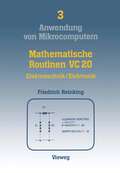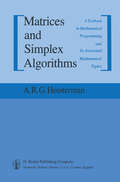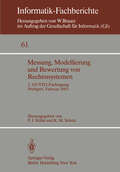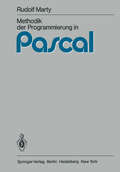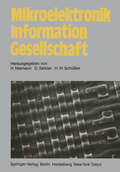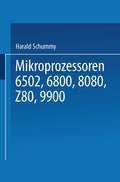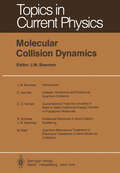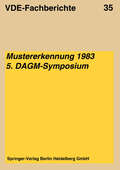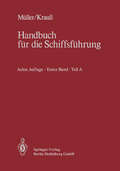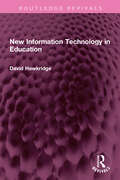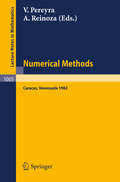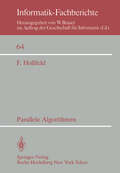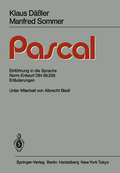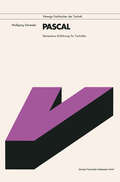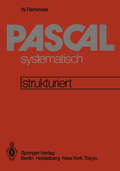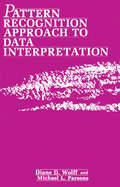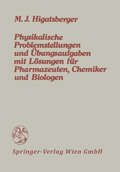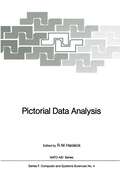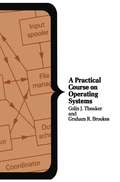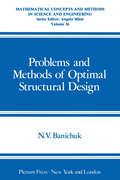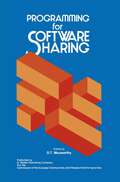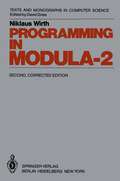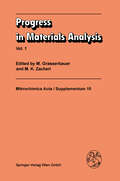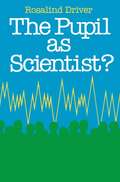- Table View
- List View
Mathematische Routinen VC 20: Elektrotechnik/Elektronik (Anwendung von Mikrocomputern)
by Ernst Friedrich ReinkingMatrices and Simplex Algorithms: A Textbook in Mathematical Programming and Its Associated Mathematical Topics
by Aaart R. HeestermanThis is a textbook devoted to mathematical programming algorithms and the mathematics needed to understand such algorithms. It was mainly written for economists, but the mathematics itself obviously has relevance for other disciplines. It is a textbook as well a~ in parts, a contribution to new knowledge. There is, accordingly, a broad ordering of climbing sophistication, the earlier chapters being purely for the student, the later chapters being more specialist and containing some element of novelty on certain points. The book is edited in five parts. Part I deals with elementary matrix operations, matrix inversion, determinants, etc. Part II is mainly devoted to linear programming. As far as students' readability is concerned, these two parts are elementary undergraduate material. However, I would claim, in particular with respect to linear programming, that I do things more efficiently than the standard textbook approach has it. This refers mainly to the search for a feasible solution i.e. Chapter 9, and to upper and lower limits, i.e. Chapter 10. I have also argued that the standard textbook treatment of degeneracy misses a relevant problem, namely that of accuracy. In short, I would invite anyone who has the task of writing or designing an LP-code, to first acquaint himself with my ideas. viii INTRODUCTION Parts III and IV are concerned with nonlinear programming.
Messung, Modellierung und Bewertung von Rechensystemen: 2. GI/NTG-Fachtagung Stuttgart, 21.–23. Februar 1983 (Informatik-Fachberichte #61)
by P. J. Kühn K. M. SchulzMikroelektronik Information Gesellschaft (Informationstechnik und Datenverarbeitung)
by H. Niemann D. Seitzer H. W. SchüsslerMikroprozessoren: 6502, 6800, 8080, Z 80, 9900 Grundlagen — Programmierung — Vergleiche — Übungen
by Harald SchumnyMolecular Collision Dynamics (Topics in Current Physics #33)
by M. BaerThis monograph covers a broad spectrum of topics in the very broad field of gas phase molecular collision dynamics. The Introduction previews each of the four fol lowing topics and attempts to sew them together with a common thread. In addition, a brief review of quantum reactive scattering is given there along with some gen eral remarks which highlight the difficulties in doing quantum reactive scatter ing calculations. The chapters are all written by theoreticians who are, of course, experts in the subjects they have written about. Three chapters, the ones by Secrest, Schatz, and the one by Schinke and Bowman deal with non-reactive atom-molecule scattering. Col lectively, they describe nearly the full breadth of scattering methods in use to day, from fully quantum mechanical to semiclassical and quasiclassical. The chapter by Baer is the only one dealing with quantum reactive scattering with the additional complexity of the coupling of two potential energy surfaces. The one simplifying feature of the treatment is that the reaction is constrained to be collinear. Overall, this monograph is mainly a review of the recent advances in the field of molecular collision dynamics, with, however, a considerable amount of new material. It is hoped that workers and students in the field will find reading the mono graph both enlightening and enjoyable.
Mustererkennung 1983: Vorträge des 5. DAGM-Symposiums vom 11.–13. Oktober 1983 in Karlsruhe
by H. KazmierczakNavigation: Teil A Richtlinien für den Schiffsdienst, Gestalt der Erde, Seekarten und nautische Bücher, terrestrische Navigation, Wetterkunde (Handbuch für die Schiffsführung #1 / A)
by J. H. Cepok C. Marcus G. OlbrückNew Information Technology in Education (Routledge Revivals)
by David HawkridgeFirst published in 1983, New Information Technology in Education surveyed developments in the field of information technology and demonstrated how it could be used to improve the quality of education. The book considered the experience of a wide range of countries, including the United States, Japan and those in Europe. While explaining the potential improvements that the new technology could bring, this book also reviewed the problem areas and helped educationalists to evaluate the relevance of the new technology for their own work. In an age of teaching via Zoom videos, it is interesting to take a look at a time when information technology in education was at its nascent stage. This book will be of interest to teachers and students of history, education, technology and pedagogy.
New Information Technology in Education (Routledge Revivals #32)
by David HawkridgeFirst published in 1983, New Information Technology in Education surveyed developments in the field of information technology and demonstrated how it could be used to improve the quality of education. The book considered the experience of a wide range of countries, including the United States, Japan and those in Europe. While explaining the potential improvements that the new technology could bring, this book also reviewed the problem areas and helped educationalists to evaluate the relevance of the new technology for their own work. In an age of teaching via Zoom videos, it is interesting to take a look at a time when information technology in education was at its nascent stage. This book will be of interest to teachers and students of history, education, technology and pedagogy.
Numerical Methods: Proceedings of the International Workshop Held at Caracas, June 14-18, 1982 (Lecture Notes in Mathematics #1005)
by V. Pereyra A. Reinozaa
Parallele Algorithmen (Informatik-Fachberichte #64)
by F. HossfeldZu den allgemeinen Einordnungen von Algorithmen ist in den letzten Jahren eine neue Klassifikation wichtig geworden: parallel versus sequentiell. Die Ursache findet sich in der nicht zuletzt durch die Entwicklungen der Halbleitertechnologie, vor allem aber durch den wachsenden Druck von Anwendungen, die höchste Rechnerleistung erfordern, erhöhten Bedeutung von Parallelprozessorarchitekturen. Das zunehmende Interesse an Parallelrechnern hat die Entwick lung von parallelen Algorithmen zur Lösung vielfältiger Problemstellungen beschleunigt. Eine Darstellung von Grundprinzipien, Entwurfsmöglichkeiten und Realisierungen paralleler Algorith men, die das Leistungspotential innovativer Rechnerarchitekturen erschließen, erscheint für die integrale Betrachtung der Thematik des "Parallel Computing" nicht nur notwendig, sondern auch - vor allem auf die deutschsprachige Fachliteratur bezogen - überfällig. Dem vorliegenden Band liegt das Skriptum -einer Spezial vorlesung gleichen Titels zugrunde, die ich im Sommersemester 1980 an der Universität Dortmund auf Einladung der Abteilung Informatik gehalten habe. Es ist nicht das Ziel, eine möglichst vollständige Sammlung der in den Zweigen dieses expansiven Forschungsgebietes bisher entwickelten parallelen Algorithmen zu liefern; vielmehr sollen mit dieser Annäherung an eine erste Gesamtdarstellung der Themati- insbesondere auch durch die Gegenüberstellung von repräsentativen sequentiellen Algorithmen - Charakteristika originärer paralleler Algorithmen aufgezeigt und ihr Bezug zu den Architektur elementen von Parallelprozessoren verdeutlicht werden. Dadurch soll auch hierzulande das Interesse an dieser immer wichtiger werdenden Fragestellung weiter gefördert und der Einstieg in die junge, über ein breites Spektrum von hauptsächlich englischsprachigen Fachzeitschriften verstreute Originalliteratur erleichtert werden; wegen der angelsächsischen Dominanz auf diesem Gebiet lassen sich dabei für die klare Begriffsbestimmung naturgemäß gewisse Anglizismen nicht vermeiden.
Pattern Recognition Approach to Data Interpretation
by Diane WolffAn attempt is made in this book to give scientists a detailed working knowledge of the powerful mathematical tools available to aid in data interpretation, especially when con fronted with large data sets incorporating many parameters. A minimal amount of com puter knowledge is necessary for successful applications, and we have tried conscien tiously to provide this in the appropriate sections and references. Scientific data are now being produced at rates not believed possible ten years ago. A major goal in any sci entific investigation should be to obtain a critical evaluation of the data generated in a set of experiments in order to extract whatever useful scientific information may be present. Very often, the large number of measurements present in the data set does not make this an easy task. The goals of this book are thus fourfold. The first is to create a useful reference on the applications of these statistical pattern recognition methods to the sciences. The majority of our discussions center around the fields of chemistry, geology, environmen tal sciences, physics, and the biological and medical sciences. In Chapter IV a section is devoted to each of these fields. Since the applications of pattern recognition tech niques are essentially unlimited, restricted only by the outer limitations of.
Physikalische Problemstellungen und Übungsaufgaben mit Lösungen für Pharmazeuten, Chemiker und Biologen
by Michael J. HigatsbergerPictorial Data Analysis (NATO ASI Subseries F: #4)
by Robert M. HaralickThis volume is the collection of lectures and presentations of the NATO AS! On Pictorial Data Analysis, held August 1-12, 1982 in the beautiful chateau de Bonas, Bonas France. The director of the AS! was Robert M. Haralick and the Co-director was Stefano Levialdi. The papers in the book are arranged in two sections first theory and general prinicples and then applications. Local computations play a central role in image processing both when a traditional computer is used and when parallel machines are used for improving image throughput. Levialdi reviews such neighborhood operators. Hung and Kasvand discuss a line thinning application which involves detection of critical points on chain encoded data. Most low level image processing has been done using the digital raster as the basic data structure. Within the last few years many of these basic algorithms have been developed for the quadtree data structure. The quadtree permits easier access to certain kinds of spatial adjacency relationships in a variable resolution context. Rosenfeld reviews the properties of these representations and their uses in image segmentation and property measurement. Besslich discusses an expanded form of an invertible quadtree representation which permits a multiprocessor execution. Gisolfi and Vitulano discuss the C-matrix and C-filtering technique for image and texture feature extraction. O'mara et.al. discuss the application of Codel numbers to image feature extraction. Kropatsch discusses an image segmentation technique which permits the effective use of a variety of different kinds of segmentation techniques.
Problems and Methods of Optimal Structural Design (Mathematical Concepts and Methods in Science and Engineering #26)
by Nikolai Vladimirovich BanichukThe author offers a systematic and careful development of many aspects of structural optimization, particularly for beams and plates. Some of the results are new and some have appeared only in specialized Soviet journals, or as pro ceedings of conferences, and are not easily accessible to Western engineers and mathematicians. Some aspects of the theory presented here, such as optimiza tion of anisotropic properties of elastic structural elements, have not been con sidered to any extent by Western research engineers. The author's treatment is "classical", i.e., employing classical analysis. Classical calculus of variations, the complex variables approach, and the Kolosov Muskhelishvili theory are the basic techniques used. He derives many results that are of interest to practical structural engineers, such as optimum designs of structural elements submerged in a flowing fluid (which is of obvious interest in aircraft design, in ship building, in designing turbines, etc.). Optimization with incomplete information concerning the loads (which is the case in a great majority of practical design considerations) is treated thoroughly. For example, one can only estimate the weight of the traffic on a bridge, the wind load, the additional loads if a river floods, or possible earthquake loads.
Programming for Software Sharing (Ispra Courses)
by D. T. MuxworthyMost computer users are familiar with the problems of sharing software with others, and the transfer of programs from one computing environment to another. Software represents an ever-increasing proportion of the cost of computing and these costs tend to nullify all the economic advantages flowing from the wider availability of cheap hardware. Years ago it was hoped that the widespread use of high-level programming languages would help in alleviating the problems of software production, by increasing productivity and by making it simpler for users with similar problems to be able to use the same programs, possibly on different types of machines. It is a common experience that in practice this simple optimism has proved to be unfounded. It was these considerations which led us in 1979 to organize a two-week course on "Programming for Software Sharing" at the European Community Joint Research Centre, Ispra Establishment (Italy), forming part of the regular series of "Ispra Courses". With prominent invited lecturers, local contributions and through discussion sessions we examined with an audience from many countries the problems involved in the sharing and transfer of software, as well as suggesting ways of overcoming them. In our local environment we are faced daily with three problems both from engagements in software exchange in the scientific-technical field on a Europe-wide or world-wide basis, and from work with programming techniques and contributions to the international standardization process.
Programming in Modula-2 (Monographs in Computer Science)
by N. WirthThis text is an introduction to programming in general, and a manual for programming with the language Modula-2 in particular. It is oriented primarily towards people who have already acquired some basic knowledge of programming and would like to deepen their understanding in a more structured way. Nevertheless, an introductory chapter is included for the benefit of the beginner, displaying in a concise form some of the fundamental concepts of computers and their programming. The text is therefore also suitable as a self-contained tutorial. The notation used is Modula-2, which lends itself well for a structured approach and leads the student to a working style that has generally become known under the title of structured programming. As a manual for programming in Modula-2, the text covers practically all facilities of that language. Part 1 covers the basic notions of the variable, expression, assignment, conditional and repetitive statement, and array data structure. Together with Part 2 which introduces the important concept of the procedure or subroutine, it contains essentially the material commonly discussed in introductory programming courses. Part 3 concerns data types and structures and constitutes the essence of an advanced course on programming. Part 4 introduces the notion of the module, a concept that is fundamental to the design of larger programmed systems and to programming as team work. The most commonly used utility programs for input and output are presented as examples of modules. And finally, Part 5 covers facilities for system programming, device handling, and multiprogramming.
Progress in Materials Analysis: Vol. 1 (Mikrochimica Acta Supplementa #10)
by M. Grasserbauer M. K. ZacherlThe 11th Colloquium on Metallurgical Analysis - a joint venture of the Institute of Analytical Chemistry of the Technical University in Vienna, the Austrian Society for Analytical Chemistry and Microchemistry, the German Metals Society (DGM), and the Society of German Iron and Steel Engineers (VDEh) - was attended by 120 scientists from 12 nations. The major topics covered were surface, micro and trace analysis of materials with a heavy emphasis on metals. According to the strategy of the meeting attention was focussed on an interdisciplinary approach to materials science - combining analytical chemistry, solid state physics and tech nology. Therefore progress reports on analytical techniques (like SIMS, SNMS, Positron Annihilation Spectroscopy, AES, XPS) were given as well as pre sentations on the development of materials (like for the fusion reactor). The majority of the discussion papers centered on the treatment of important technical problems in materials science and technology by a (mostly sophis ticated) combination of physical and chemical analytical techniques. The intensive exchange of ideas and results between the scientists oriented towards basic research and the industrial materials technologists was very fruitful and resulted in the establishment of several scientific cooperations. Major trends in materials analysis were also dealt with in a plenary discussion of which a short summary is contained in this volume. In order to facilitate international communication in the field of materials analysis and in view of the important questions treated in the various contri butions this proceedings volume was edited in English.
Pupil As Scientist (UK Higher Education OUP Humanities & Social Sciences Education OUP)
by Rosalind DriverThe Pupil as Scientist intends to give teachers and student teachers a better understanding of the thinking of young adolescent pupils in science lessons and to indicate the difficulties such pupils have in understanding the more abstract or formal ideas with which they are presented. It is practical in its orientation as the issues discussed are illustrated with examples drawn from dialogue and observations made in science classes.One of Rosalind Driver's main themes is that science teachers must recognise more fully and act upon the preconceptions and alternative frameworks which pupils bring to their study of science.Despite is practical orientation, the book addresses some fundamental questions arguing for a reappraisal of science teaching in secondary schools in the light of developments in cognitive psychology and philosophy of science.This is an accessible, authoritative and very helpful book for all concerned with the teaching of science in the secondary years.
